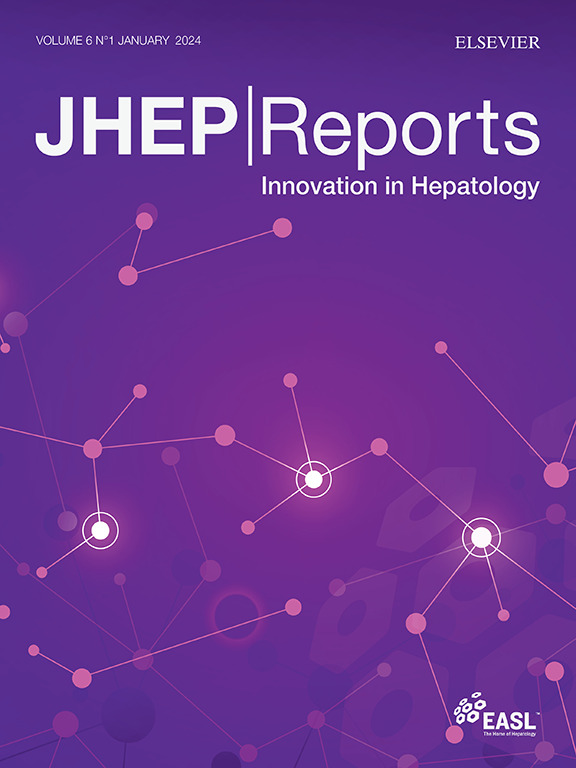Resolvin d1介导的细胞串扰对MASH有保护作用
IF 9.5
1区 医学
Q1 GASTROENTEROLOGY & HEPATOLOGY
引用次数: 0
摘要
背景,最近的研究强调了resolvin D1 (RvD1),一种由二十二碳六烯酸衍生的特殊促溶解介质,对慢性肝脏疾病的有益作用,但其潜在机制尚不清楚。我们的研究旨在确定rvd1介导的细胞串扰在代谢功能障碍相关脂肪性肝炎(MASH)中的作用和机制。方法srvd1经实验性MASH灌胃,进行大鼠和单细胞RNA测序(scRNA-seq)分析。分离原代肝细胞,包括原代肝细胞、库普弗细胞(KCs)、T细胞和肝星状细胞(hsc)进行共培养实验,以阐明RvD1对细胞死亡、炎症和纤维化的影响。结果小鼠(n = 5 ~ 6, p <0.01)和人(n = 9 ~ 10, p <0.05)肝组织RvD1水平均降低。给予RvD1可减少MASH患者的肝细胞死亡、炎症和肝纤维化(n = 4-5, p <0.05)。机制上,RvD1通过抑制内质网(ER)应激降低肝细胞死亡。与原代肝细胞共培养实验表明,棕榈酸处理肝细胞的条件培养基激活了KCs、T细胞和hsc;然而,在rvd1预处理的肝细胞中,这些作用被消除。此外,RvD1直接抑制T细胞活化和IFNγ产生,导致KCs中Stat1-Cxcl10信号通路减少。结论srvd1通过减轻内质膜应激介导的凋亡,降低KCs、T细胞和hsc的活化,从而降低肝细胞死亡和DAMP的产生。这项研究强调了rvd1介导的不同肝细胞间的细胞串扰在MASH中的新作用。影响和影响smash是世界范围内日益增长的医疗保健负担。然而,目前对MASH及其后遗症的治疗仍然有限。最近的研究强调了包括RvD1在内的特殊促溶解介质(SPMs)在肝脏疾病中的治疗益处。然而,这些有益作用背后的机制尚不清楚。基于一系列共培养原代细胞实验和无偏倚转录组学分析,我们发现rvd1介导的肝细胞和非实质细胞之间的细胞串扰可以防止MASH进展。我们的研究为RvD1在MASH中的作用提供了新的机制见解,并强调了其治疗这种疾病的潜力。本文章由计算机程序翻译,如有差异,请以英文原文为准。

Resolvin D1-mediated cellular crosstalk protects against MASH
Background & aims
Recent studies have highlighted the beneficial effect of resolvin D1 (RvD1), a docosahexaenoic acid-derived specialized pro-resolving mediator, on chronic liver diseases, but the underlying mechanisms are not well understood. Our study aimed to determine the role and mechanism of RvD1-mediated cellular crosstalk in metabolic dysfunction-associated steatohepatitis (MASH).
Methods
RvD1 was administered to mice with experimental MASH, followed by bulk and single cell RNA sequencing (scRNA-seq) analysis. Primary liver cells, including primary hepatocytes, Kupffer cells (KCs), T cells, and hepatic stellate cells (HSCs), were isolated for co-culture experiments to elucidate the effect of RvD1 on cell death, inflammation, and fibrosis.
Results
Hepatic tissue levels of RvD1 were decreased in murine (n = 5–6, p <0.01) and human MASH (n = 9–10, p <0.05). Administering RvD1 reduced hepatocellular death, inflammation, and liver fibrosis in MASH (n = 4–5, p <0.05). Mechanistically, RvD1 reduced hepatocyte death by suppressing endoplasmic reticulum (ER) stress. Co-culture experiments with primary liver cells showed that conditioned media from palmitic acid-treated hepatocytes activated KCs, T cells, and HSCs; however, those effects were abolished from RvD1-pretreated hepatocytes. Moreover, RvD1 directly suppressed T cell activation and IFNγ production, leading to reduced Stat1-Cxcl10 signaling in KCs.
Conclusions
RvD1 reduced hepatocyte death and DAMP production by alleviating ER stress-mediated apoptosis, leading to decreased activation of KCs, T cells, and HSCs. This study highlights the novel role of RvD1-mediated cellular crosstalk among different liver cells in MASH.
Impact and implications
MASH is a growing healthcare burden worldwide. However, current treatments for MASH and its sequelae remain limited. Recent studies highlighted the therapeutic benefit of specialized pro-resolving mediators (SPMs), including RvD1, in liver diseases. However, the mechanisms underlying these beneficial effects are not well understood. Based on a series of co-culture primary cell experiments and unbiased transcriptomic analyses, we show that RvD1-mediated cellular crosstalk among hepatocytes and nonparenchymal cells protects against MASH progression. Our study provides a new mechanistic insight into the role of RvD1 in MASH and highlights its therapeutic potential to treat this condition.
求助全文
通过发布文献求助,成功后即可免费获取论文全文。
去求助
来源期刊

JHEP Reports
GASTROENTEROLOGY & HEPATOLOGY-
CiteScore
12.40
自引率
2.40%
发文量
161
审稿时长
36 days
期刊介绍:
JHEP Reports is an open access journal that is affiliated with the European Association for the Study of the Liver (EASL). It serves as a companion journal to the highly respected Journal of Hepatology.
The primary objective of JHEP Reports is to publish original papers and reviews that contribute to the advancement of knowledge in the field of liver diseases. The journal covers a wide range of topics, including basic, translational, and clinical research. It also focuses on global issues in hepatology, with particular emphasis on areas such as clinical trials, novel diagnostics, precision medicine and therapeutics, cancer research, cellular and molecular studies, artificial intelligence, microbiome research, epidemiology, and cutting-edge technologies.
In summary, JHEP Reports is dedicated to promoting scientific discoveries and innovations in liver diseases through the publication of high-quality research papers and reviews covering various aspects of hepatology.
 求助内容:
求助内容: 应助结果提醒方式:
应助结果提醒方式:


